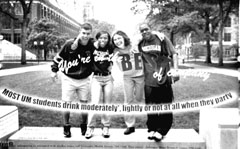The University Record, July 19, 1999 By Joel Seguine
News and Information Services

A committee of students, faculty and administrators has made dozens of recommendations aimed at the problem of high-risk, binge drinking, especially among first-year students.
The standard definition for binge drinking is five or more drinks for men and four or more drinks for women in a single sitting or occasion. High-risk drinking is defined as having significant negative consequences for the drinker and/or someone else. These can be legal, personal, health-related, social or academic/occupational, immediate or long-term, direct or indirect.
Among the recommendations of the Binge Drinking Committee, released July 7, are:
The committee was formed by former Vice President for Student Affairs Maureen Hartford in August 1998. She charged the group with “identifying strategies to reduce harmful, high-risk drinking—and the negative consequences of this drinking—among first-year students, particularly those residing in on-campus residence halls.”
“I’m very impressed with the wide range of recommendations the committee has made,” said Royster Harper, interim vice president for student affairs. “As the members have clearly recognized, there isn’t a quick fix to this problem. As we move to the next phase of addressing the issues surrounding binge drinking we will want to engage students, faculty and staff as we answer the question, ‘What kind of community do we want to be?’ As such,” Harper added, “I want right away to weave some of the recommendations into our overall efforts in building community at Michigan.”
To facilitate the committee’s work, four sub-committees—Prevention/Education, Policy, Curriculum, Communications/Community Relations—were charged with developing goals and strategies that the full committee organized into eight categories of recommendations: central coordination and leadership; ongoing monitoring via research; campus policy; specific new initiatives for prevention; specific new initiatives for counseling and intervention support; specific new initiatives for education, both curricular and co-curricular; community relations.
Other recommendations of the committee include:
The recommendation the Binge Drinking Committee characterizes as its strongest is appointment of a committee similar to itself that will continue its work, specifically in getting additional student input, identifying liaisons in other units, overseeing implementation of recommendations that can be acted on quickly, and evaluating recommendations in the report and new ones that will arise.
The full text of the report, “Initial Report and Recommendations to Reduce Risky Drinking of First-Year Students in Residence Halls,” is on the Web at www.umich.edu/~newsinfo/BG/drinkrep.html.
The Binge Drinking Committee was chaired by Marsha Benz, program associate, University Health Service. J. Ann Hower, director, Office of New Student Programs, and Deborah Kraus, clinical psychologist, Counseling and Psychological Services were co-chairs. Other members are:
April J. Bayles, Student-Athlete Development Office; Carol Boyd, Substance Abuse Research Center; James Christie, 1998–99 Residence Hall Association president; Mary J. Gray, 1998 Panhellenic president; Sean E. McCabe, Office of the Vice President for Student Affairs;
John R. Mountz, Office of Greek Life; Philip Parker, parent and psychiatrist; David Schoem, Office of the Provost and Office of the Vice President for Student Affairs; Beth Patterson, residence adviser and sorority member; John Schulenberg, Institute for Social Research;
Trent Thompson, president, Michigan Student Assembly; Bill Zeller, University Housing; and Janet Zielasko, University Health Service.
Committee affiliates were Sarah Alvarez, student; Jeff Brake, Campus Information Centers; and Joel Seguine, News and Information Services.

